Tornadoes of 2001
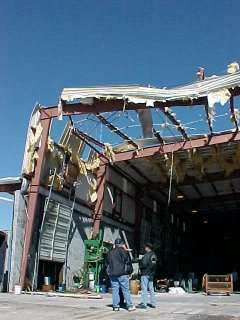 Damage from the October 24 Midwestern tornado outbreak | |
| Timespan | January - December 2001 |
|---|---|
| Maximum rated tornado |
F4 tornado
|
| Tornadoes in U.S. | 1,215[1] |
| Damage (U.S.) | $630 million |
| Fatalities (U.S.) | 40[2] |
| Fatalities (worldwide) | >40 |
This page documents the tornadoes and tornado outbreaks of 2001, primarily in the United States. Most tornadoes form in the U.S., although some events may take place internationally.
Events
| F0 | F1 | F2 | F3 | F4 | F5 | Total |
|---|---|---|---|---|---|---|
| 810 | 278 | 98 | 23 | 6 | 0 | 1215 |
January
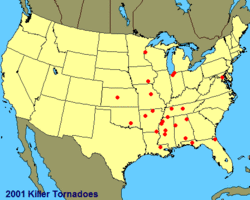
- January 19
Four minor tornadoes were caused by a bow echo in Georgia and Alabama. Four people were injured by an F0 near Montgomery, Alabama. Eight more were injured when another F0 struck a shopping center near Hartsfield International Airport. Two other tornadoes in Georgia (an F0 and an F1) caused negligible damage and no injuries.[3]
February
- February 16
An F2 tornado touched down near Goodman, Mississippi damaging cabins, downing trees, and tossing vehicles. One woman was crushed to death by her car after abandoning it for a ditch—considered better shelter from a tornado than a vehicle. Four F0 tornadoes also occurred, with no injuries.[3]
- February 24–25
| F0 | F1 | F2 | F3 | F4 | F5 |
|---|---|---|---|---|---|
| 8 | 7 | 7 | 3 | 0 | 0 |

A moderate tornado outbreak affected several southern US states. A line of tornado-producing supercells formed out in front of a squall line which produced damaging winds. Over ten hours, multiple tornadoes touched down and caused $35 million in damage, primarily in Arkansas and Mississippi.
The outbreak began on the 24th, and multiple tornadoes began touching down in Arkansas that evening. An F2 that impacted the towns of Sweet Home and College Station, destroying homes, mobile homes, and a church. The tornado downed many trees and power lines and injured 8 people.[4] Another F2 tornado near Union heavily damaged a dairy barn and the roofs of several homes. Many trees were downed, and three mobile homes were destroyed, resulting in a fatality and 3 injuries.[5] An F3 tornado touched down near Reed, and moved northeast. Roofs were damaged at several homes. In addition, the tornado rolled a 500-gallon butane tank, damaged or destroyed metal barns and sheds, and knocked down hundreds of trees. Near the town of Kelso, the tornado completely destroyed a metal farm shop, and pieces of debris from the structure were found 6 miles away. Also near the shop, a pickup truck was mangled with several large farm implements thrown, overturned or destroyed. A tractor-trailer was flipped before the tornado dissipated near Snow Lake.[6]
Tornado activity began to spread into Mississippi later that night, and an F3 caused major damage near Greenwood.[7] Another F3 touched down near Bruce before moving east and slamming into Pontotoc, where major damage occurred. At least 360 homes, 15 businesses and 2 churches were damaged or destroyed in Pontotoc. Among the homes destroyed was a restored antebellum plantation home listed in the National Register of Historic Places. Numerous trees and power lines were blown down. Six people were killed in town, and 43 others were injured. The tornado then struck Baldwyn, where 100 homes were damaged or destroyed, and the Baldwyn High School which lost the roof to its gymnasium. Past Baldwyn, the tornado struck Guntown, where 8 homes and 1 business were heavily damaged, while 13 other structures were damaged. Lesser damage occurred in Saltillo and Wheeler before the tornado dissipated. Additional weak tornadoes occurred in Tennessee on the 25th before the event came to an end. Overall, the outbreak produced 25 tornadoes and killed 7 people.[8][9]
March
- March 12–13
| F0 | F1 | F2 | F3 | F4 | F5 |
|---|---|---|---|---|---|
| 6 | 10 | 1 | 0 | 0 | 0 |
A small progressive tornado outbreak stretched from Texas to Georgia. At 3:30AM, an F1 tornado touched down outside of Tatum, Texas, moving into the town and causing damage to several structures. Two F0s were reported later in the morning in and around Kentwood, Louisiana. Nine more minor tornadoes struck southern Mississippi that morning, including F1s which injured 7 and 5 in Lamar County and Forrest County, respectively. In the afternoon, an F1 tornado destroyed several mobile homes in Red Level, Alabama, killing two people and injuring another.[10] Another F1 also destroyed mobile homes near Boykin, Georgia later in the afternoon, injuring 2.[11] After midnight, three tornadoes touched down in extreme northern Florida, including an F2 in Hamilton County and an F1 which injured 5 and caused $5 million in damage to Daytona Beach.[3]
- March 15
| F0 | F1 | F2 | F3 | F4 | F5 |
|---|---|---|---|---|---|
| 2 | 0 | 5 | 0 | 0 | 0 |
A small outbreak of 7 tornadoes struck northern Florida and southern Georgia between 4:30 and 8:30AM. An F2 struck a residential area near Wausau, Florida at 4:30AM, killing one person and injuring 21. Another two F2s hit further north near Round Lake and Kinard, causing minimal damage. Yet another 2 F2s injured 13 in Decatur and Grady Counties in Georgia.[3]
- March 29
A small outbreak struck northern Florida on the morning of the 29th. Two F2s and four F0s injured one person and caused a few million dollars in damage.[3]
April
- April 6
An F2 injured 2 in the southwestern corner of Kansas.[12]
- April 8
An F1 injured one person as it destroyed a trailer in Mount Etna, Iowa. The main impact that day was a major hailstorm across much of Iowa.[13]
- April 9
A small F2 touched down near Lowellville, Ohio, two F0s struck Pennsylvania, and one F0 occurred in north-central Illinois. No significant damage or injuries were reported with any of these tornadoes.
- April 10–11
| F0 | F1 | F2 | F3 | F4 | F5 |
|---|---|---|---|---|---|
| 37 | 43 | 16 | 1 | 0 | 0 |
An extended tornado outbreak consisting of 97 tornadoes struck the central Great Plains. The outbreak killed 4 and injured 18, and occurred in three stages.
It began when a strong area of storms moved across eastern Kansas and adjacent Missouri on the afternoon of the 10th. One supercell passed over northern St. Louis producing ten tornadoes, one of which (an F1) destroyed a mobile home, killing one and injuring two. Tornadoes occurred as far east as southwestern Illinois,[12][14] but the supercell is more memorable for exceptionally widespread large hail. With some hailstones up to baseball size, the swath is the largest continuous in areal coverage and longest in length and duration of very large hail known. Because of the extensive area and heavily populated areas impacted, it is the costliest hailstorm in U.S. history, with $2 billion of insured losses.[15]
The next stage of the outbreak was a swarm of tornadoes which formed on the night of the 10th into the pre-dawn hours of the 11th in Texas, Oklahoma, Kansas and Nebraska. One person was killed and eleven were injured in this stage, mostly by F2 tornadoes.[3]
After a short break, a third bunch of tornadoes were spawned in and close to the state of Iowa in the late morning through the afternoon. Mostly weaker tornadoes, there were a few significant tornadoes. One, an F2, destroyed a lodge in the town of Agency, killing two people and injuring three. All told, more than $23 million in damage was attributed to the entire outbreak.[3][16]
- April 14–15
| F0 | F1 | F2 | F3 | F4 | F5 |
|---|---|---|---|---|---|
| 2 | 3 | 1 | 0 | 0 | 0 |
A few tornadoes touched down in Kansas and Missouri late on the 14th into the early morning of the 15th. Just after midnight, an F1 touched down near Redings Mill, Missouri, damaging several homes and flipping over a trailer, injuring one person.[17]
- April 17
Two minor tornadoes touched down in far eastern North Carolina.[3]
- April 21
| F0 | F1 | F2 | F3 | F4 | F5 |
|---|---|---|---|---|---|
| 9 | 0 | 1 | 0 | 1 | 0 |
An outbreak of eleven tornadoes hit central Kansas. While mainly minor, one was a violent F4, which struck without a tornado warning being issued. Touching down just outside Hoisington, it tore a two-block-wide path through the north and west sides of town, completely destroying almost 200 homes and businesses and damaging another 230. The roof of the local hospital was partially torn off, and vehicles were tossed and mangled. The tornado caused $43 million in damage. Twenty-eight people were injured, and one man was killed by a flying vehicle.[18]
Other tornadoes in the outbreak included an F2 which heavily damaged two farms, and 10 scattered F0s.[3]
Additionally, a rare tornado struck the three state junction area of California, Arizona, and Nevada, crossing the Colorado River and causing minimal damage.[19]
- April 22
Two minor tornadoes touched down in Nebraska. One, an F1, injured a man outside of Blair.[3]
- April 23
Two minor tornadoes again touched down, this time in Iowa. One, an F1, injured three people and damaged dozens of homes in Independence.[3]
- April 30
Three F0 tornadoes produced little or no damage in Iowa.
May
- May 1
Ten tornadoes touched down in Minnesota and Wisconsin. One, an F2, damaged 100 homes in Glenville, Minnesota, resulting in $20 million in damage.[3]
- May 4
Several weak tornadoes struck northern Texas and central Oklahoma, injuring 4 people. Another mini-outbreak of seven F0 tornadoes touched down in extreme southeastern Nebraska and northwestern Missouri, causing minimal damage and no injuries.[12]
- May 9
A small tornado outbreak passed mostly over open fields in Minnesota. One tornado did cause significant damage—one man was injured, and at least 30 structures were damaged or destroyed resulting in $20 million of damage.[3]
- May 10
| F0 | F1 | F2 | F3 | F4 | F5 |
|---|---|---|---|---|---|
| 7 | 2 | 2 | 0 | 0 | 0 |
A number of tornadoes, some significant, touched down across central Iowa. Although more than $300,000 in damage was done, there were no injuries.
- May 15
A small local outbreak of 8 F0 tornadoes hit northwestern Minnesota, causing minimal damage and no injuries.
- May 20
| F0 | F1 | F2 | F3 | F4 | F5 |
|---|---|---|---|---|---|
| 28 | 3 | 1 | 0 | 0 | 0 |
A moderate outbreak of tornadoes stretched across much of Kansas, Oklahoma, and Arkansas. Mostly minor, there was one significant F2 tornado near Dustin, Oklahoma.[12][20]
- May 21
| F0 | F1 | F2 | F3 | F4 | F5 |
|---|---|---|---|---|---|
| 15 | 6 | 3 | 0 | 0 | 0 |
Another moderate outbreak occurred, mainly on the Lower Peninsula of Michigan. A few also occurred in eastern Ohio, and one in West Virginia. An F2 touched down in Hartland, Michigan, and caused significant damage to the town, mostly to hundreds of damaged and totalled vehicles. This tornado also destroyed a towing company and damaged a manufacturing plant to the north. Three people were injured by this tornado. Three others were injured in three separate F1 tornadoes, in Elwell, Michigan, Shepherd, Michigan, and Canton, Ohio. The outbreak caused more than $7 million in damage.[3]
- May 27
A small group of touchdowns occurred over western Kansas. Additionally, four tornadoes, one significant, struck the Mid-Atlantic states, including an F2 which caused $1 million in damage north of Manalapan, New Jersey.[12][21]
- May 28
A stationary supercell dropped large amounts of rain and hail near Ellicott, Colorado, as well as four brief tornadoes.
- May 29
| F0 | F1 | F2 | F3 | F4 | F5 |
|---|---|---|---|---|---|
| 23 | 3 | 0 | 2 | 0 | 0 |
A moderate tornado outbreak hit the southwestern Great Plains, mainly in the form of F0 tornadoes in Colorado, Kansas, and the Texas Panhandle. One supercell produced six weak landspouts and a large F3 tornado near Lamar, Colorado. The Lamar tornado completely destroyed a modular home and five vehicles in its vicinity, and damaged two other homes nearby. Eleven power poles were destroyed as well. Another F3 destroyed a home and an office building near Panhandle, Texas. The only casualty from this outbreak was from a large F1 tornado which blew over a semi-truck outside of Quanah, Texas, badly injuring the driver.[12][22][22][23]
In Poland one F2 tornado touched down in Podhale region, and damaged 144 buildings in Morawczyna and Bielanka, Nowy Targ County.[24]
- May 31
Four tornadoes touched down in Tennessee and extreme southern Kentucky. One F2 destroyed several structures, killing one person and injuring two people in Auburntown, Tennessee. One of the injuries was to a pregnant woman, who also lost her baby.[12][25]
June
- June 1
An outbreak of 18 weak tornadoes struck the state of Iowa. Additionally, an F1 tornado injured three people in Menola, North Carolina.[3][12]
- June 2 (Puerto Rico)
An F2 tornado hit London, Kentucky, causing major damage to shopping centers, vehicles, and mobile homes, injuring ten people.[26]
- June 3
A rare Puerto Rico tornado touched down in Añasco. No injuries were reported, but several roofs were detached.[3]
Additionally, a small outbreak of six tornadoes struck open country in south-central Kansas, causing very minor damage and no injuries.[3]
- June 5
| F0 | F1 | F2 | F3 | F4 | F5 |
|---|---|---|---|---|---|
| 16 | 1 | 0 | 0 | 0 | 0 |
Another minor outbreak, mainly consisting of landspouts, occurred over northwestern Texas and south-central Kansas. Minor damage to farm equipment was the only loss from the 17 confirmed tornadoes.[3]
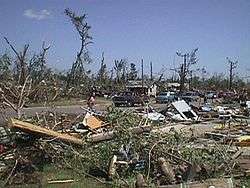
- June 7
An F1 tornado blew a tree down onto a truck in Zachary, Louisiana, killing the driver.[27]
- June 9
A slew of minor tornadoes (15 F0s and an F1) caused little damage and minor injuries in the northern Great Plains.
- June 11
A minor outbreak produced 19 tornadoes in Minnesota and Wisconsin. The most notable of these was a large F2 tornado which struck Benson, Minnesota, injuring seven people (one critically) and causing $10 million in damage.[3][28] In an unrelated storm system, a man was killed in his living room by a tree blown down by an F0 in Jacksonville, Florida.[27]
- June 12
The remnants of Tropical Storm Allison (2001) produced 10 tornadoes in South Carolina and Georgia, all weak and brief in duration. Twenty-two other very weak tornadoes were reported across the northern Great Plains as well.[3]
- June 13
| F0 | F1 | F2 | F3 | F4 | F5 |
|---|---|---|---|---|---|
| 28 | 5 | 2 | 1 | 1 | 0 |
A fairly large tornado outbreak of mostly weak tornadoes occurred in the Central Plains, however four of the tornado were strong to violent. A destructive F3 passed near Parkers Prairie, Minnesota. Many irrigation systems were overturned, trees, power poles, and lines were snapped, and grain bins destroyed by the strong wind. An estimated 100 poles were broken off leaving nearly 1,100 people without power. Several farmsteads were heavily damaged or destroyed in the area, and 3 people were injured.[29] A large and slow-moving F4 tornado occurred near Ruby, Nebraska. The tornado destroyed an entire farmstead, along with several propane and anhydrous ammonia tanks. Several vehicles were tumbled and tossed into a field across from the farm house. Barns, machine sheds, and outbuildings were destroyed as well.[30] An F2 near Flensburg, Minnesota tore the roof off of a house and destroyed several outbuildings.[31] A large half-mile wide tornado also touched down near Brainerd, Minnesota. The tornado tore roofs off houses and blew out exterior walls. Pole barns and sheds were destroyed, and windows were blown out. Thousands of trees were knocked down, and 41 head of livestock were killed as well. The Brainerd tornado was rated F2.[32] Overall, the outbreak produced 36 tornadoes.
- June 18
Three people were killed, with sixteen injured, by an F3 tornado in Wisconsin. It first caused severe damage as a mile-wide tornado in the town of Siren, where it destroyed 200 homes. The three deaths occurred in Dewey Township, where many homes destroyed. About 14,000 acres (57 km2) of trees were downed along its 30-mile path.[33]
- June 23
An isolated supercell produced three tornadoes in Connecticut. The first, an F1, hit a golf course in the town of Washington, demolishing a storage building and a tennis court, and injuring one person. The second tornado, rated an F2, touched down in Torrington near Torrington Middle School, damaging the roof and destroying bleachers and a storage shed. The final tornado, an F0, produced minor damage to the East Hartland fire station.[34][35][36]
July
- July 6
Two tornadoes struck the Myrtle Beach, South Carolina area. The first tornado was an F1 which crossed U.S. Route 17 in North Myrtle Beach, only on the ground for 0.1 miles. The second tornado moved slowly down the beach, alternately moving on and offshore several times, and causing significant damage, including blown-out windows, tipped-over busses, and damaged roofs and utility poles. Thirty nine people received minor injuries from this second tornado, which was rated F2.[37]
- July 17
A few weak tornadoes touched down in Minnesota and Nebraska. A lone F2 caused $1.5 million in damage on a 29-mile path through North Dakota, but no injuries were reported.[12]
| F0 | F1 | F2 | F3 | F4 | F5 |
|---|---|---|---|---|---|
| 21 | 2 | 1 | 1 | 0 | 0 |
- July 18
A moderate outbreak of weak tornadoes occurred across The Dakotas and Minnesota. Aside from an F3 tornado near Pekin, North Dakota and an F2 in south of Bowdle, South Dakota, no significant damage was reported.[3]
- July 24
An F1 tornado tracked 16 miles (26 km) across northeastern Maine, damaging a large area of trees as well as some buildings and cars in and around Oakfield.
September
| F0 | F1 | F2 | F3 | F4 | F5 |
|---|---|---|---|---|---|
| 1 | 3 | 1 | 1 | 1 | 0 |
- September 24
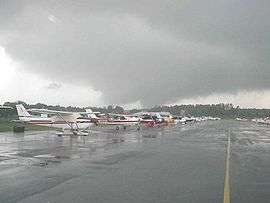
Six tornadoes struck in and around the D.C. Metro Area, two of which were significant. The first, a destructive F4, touched down in Culpeper County near Rixeyville, completely destroying a brick home, then destroying several mobile homes, injuring two. In Jeffersonton, it damaged or destroyed a dozen structures. It passed into Fauquier County, damaging a large forested area and a barn.
Another tornado passed through densely populated areas in Fairfax and Arlington Counties into Washington D.C., causing F1 damage. Shortly afterwards, the worst tornado of the outbreak touched down from the same supercell in northern D.C., near Children's Hospital. This tornado was a large multiple vortex tornado, but caused no major damage until it reached Hyattsville. From there, it rapidly strengthened, causing F3 damage as it approached the University of Maryland western campus. There, 48 people were injured by flying debris. Additionally, two women were killed when the car they were in was thrown over an eight-story building into a wooded area. The tornado then turned into a residential area, causing major damage, and approached I-95. Miraculously, even though there were thousands of cars in traffic on the highway, only one truck was flipped over. Continuing north-northeast, the tornado continued to cause significant damage to trees, residences, and other structures, including the National Agricultural Research Center and several schools, before finally lifting in Howard County, near Columbia. This tornado caused $100 million in damage.[38][39]
Another tornado caused F2 damage in Pennsylvania, and other touchdowns occurred New York and North Carolina. In all, the outbreak of nine tornadoes caused more than $105 million in damage, killed two people, and injured 59.[3][40]
October
- October 9
An unusual October tornado outbreak occurred across the Great Plains states, mainly in Oklahoma and Nebraska.[41] A large multiple-vortex F3 tornado caused considerable damage near Polk, Nebraska, and blew a farmhouse off its foundation into some nearby trees. An F2 near Fullerton tore the roof off of a house and destroyed two metal outbuildings.[42]
In Oklahoma, a destructive F3 ripped directly through the town of Cordell, where major damage occurred and 9 people were injured. 447 homes were damaged, 132 of which were left uninhabitable. 40 businesses were damaged as well, 22 of which were left uninhabitable. Some of the homes in town were leveled, and an F4 rating was considered, though it was later determined that these homes were not well-built. The Cordell tornado caused $100,000,000 in damage.[43] Another F3 touched down near Elk City and moved east through rural areas. Fences and trees were knocked down, and a brick home was left with only a few interior walls standing.[44] Yet another F3 tornado passed near Mountain View, flattening a diesel shop, an unanchored home, a barn, a garage, and an old schoolhouse near the beginning of the path. Several vehicles and pieces of farm equipment were tossed and destroyed in that area as well. Further along the path, a farm was leveled and 3 homes sustained major damage. A 10,000-gallon diesel tank was thrown a quarter-mile nearby. The tornado dissipated after injuring one person. Overall, the outbreak produced 30 tornadoes.[41][45]
- October 24
Twenty-five tornadoes broke out in southern Lower Michigan, northern Indiana, and northwestern Ohio.[46] [47] [48] [49] [50] The strongest tornado was an F3 that struck western Saint Joseph County, Indiana.
The outbreak was caused by an extremely deep low pressure system that was detected as early as Saturday, October 20 moving in on the coast of California. The Storm Prediction Center was already predicting a chance of thunderstorms on Wednesday. The area forecast discussion started mentioning a "severe potential" on Tuesday, also mentioning "severe storms with large hail and damaging winds possible". By the morning of October 24, the SPC was on its highest alert after issuing a "high risk" for severe weather for Indiana, middle Kentucky, eastern Illinois, southern Michigan, and western Ohio. The surrounding area was in a slight risk. At 5:00 A.M., a severe weather outlook was issued highlighting the fact that the area was under a high risk as well as a possibility of tornadoes. By 11:30 A.M., the SPC issued a Public Severe Weather Outlook calling for "intense tornadoes" in the area. Fifteen minutes later, the SPC issued a tornado watch for northern Indiana, and northwestern Ohio. The watch was a PDS: A "particularly dangerous situation".
At around 12:30 P.M., a line of storms began forming in central and eastern Illinois and moved east. The town of Monticello, Illinois was struck by an F2 tornado, where homes and businesses were severely damaged.[51] At around 3:12 P.M., a tornado warning was issued for LaPorte County. This tornado killed a 50-year-old woman when her modular home was swept away near LaPorte. It was an F2 on the Fujita scale. At 3:15, another tornado watch was issued for southern Michigan.
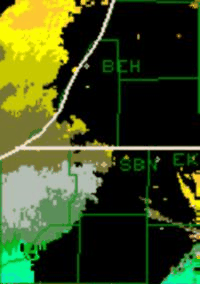
At 3:46, another tornado warning was issued for St. Joseph County, Indiana and southeastern Berrien County, Michigan and Cass County. A few minutes later, another tornado, perhaps the strongest of the outbreak—an F3—touched down and did major damage to buildings in Crumstown, a town near South Bend. The line moved into South Bend at exactly 4:05 P.M., producing 89 mph (140 km/h) winds at the airport. The tornado that hit Crumstown later hit Niles in Berrien County, then moved east-northeast into Cass County and dissipated in northwestern Saint Joseph County, Michigan. Two people were injured by the Crumstown tornado, and one man later died of his injuries. The storms prompted tornado warnings in Kalamazoo and Calhoun counties, and skies reportedly turned very green as the storms approached. The storms caused major damage to the Schoolcraft area of Kalamazoo County, where straight line winds in excess of 120 miles per hour reported, causing a golf dome to blow away, ripping the roof off a house, ripping the front wall of a brick house off and twisting irrigation sprinkler systems. Strong winds were also reported in the City of Kalamazoo. In Calhoun County, strong straight line winds also struck near Tekonsha, causing damage.
Other weaker tornadoes touched down in Mishawaka and moved northeast into Elkhart County. In Elkhart County, one of two separate tornadoes hit a Toll Road Maintenance Building and the other briefly touched down in the Cobus Green Trailer Court to the south-doing some damage to a few trailers. Another tornado damaged a trailer and a house in Marshall County and moved east into Kosciusko County and dissipated in Noble County. This particular tornado was photographed by meteorologists as it came near their forecast office in North Webster. Prior to the photo being taken, the tornado hit a factory on the north side of Warsaw, Indiana.
Later in the evening the severe storm produced straight line winds through the campus of Michigan State University downing many trees and damaging buildings. The National Weather Service estimates most of the downbursts through East Lansing were between 60-80 mph, with one reaching 120 mph (190 km/h). The supercell that passed through East Lansing also spawned 2 tornadoes in the Saginaw area. By 5:30 p.m., the severe weather moved out of Indiana and into Ohio where damage was not as severe. One tornado was reported in Ohio, an F3 that moved from Paulding County into Putnam County. That tornado caused major structural damage to buildings near Fort Jennings, Ohio.[52] The severity of the activity began to wane later that evening. By 7:30, all severe weather watches were discontinued.
November
- November 23–24
A powerful storm system on November 23–24, produced a series of strong tornadoes across the Southern United States. Multiple supercell thunderstorms developed and produced numerous tornadoes. Some of these tornadoes were strong/violent and were long tracked. A total of 13 people were killed. This is one of the most intense Fall tornado outbreaks on record.
December
- December 26
A waterspout hit several yachts during the Sydney to Hobart Yacht Race. No major injuries were reported, but several boats had to drop out of the race due to damage from the waterspouts and golfball-size hail.[53]
See also
External links
- U.S. tornadoes in 2001 - Tornado History Project
- Tornado Project tornadoes of 2001
- Storm Data "2001 Annual Summaries" (NCDC)
- Western Oklahoma Tornado Outbreak of October 9, 2001
- The Central/Southern Oklahoma and Western North Texas Tornadoes of April 11, 2001
References
- ↑ "U.S. Annual Tornado Maps (1952 - 2011): 2001 Tornadoes". Storm Prediction Center. National Oceanic and Atmospheric Administration. Retrieved May 14, 2015.
- ↑ "Annual U.S. Killer Tornado Statistics". Storm Prediction Center. National Oceanic and Atmospheric Administration. Retrieved January 18, 2016.
- 1 2 3 4 5 6 7 8 9 10 11 12 13 14 15 16 17 18 19 20 21 22 NCDC Storm Events-Select State
- ↑ "Storm Events Database". NCDC. NCDC. Retrieved January 25, 2014.
- ↑ "Storm Events Database". NCDC. NCDC. Retrieved January 25, 2014.
- ↑ "Storm Events Database". NCDC. NCDC. Retrieved January 25, 2014.
- ↑ "Storm Events Database". NCDC. NCDC. Retrieved January 25, 2014.
- ↑ "Storm Events Database". NCDC. NCDC. Retrieved January 25, 2014.
- ↑ "Storm Events Database". NCDC. NCDC. Retrieved January 25, 2014.
- ↑ NCDC: Event Details
- ↑ NCDC: Event Details
- 1 2 3 4 5 6 7 8 9 Data from the Storm Prediction Center archives, which are accessible through SeverePlot, free software created and maintained by John Hart, lead forecaster for the SPC.
- ↑ NCDC: Event Details
- ↑ NCDC: Event Details
- ↑ April 10th 2001
- ↑ NCDC: Event Details
- ↑ NCDC: Event Details
- ↑ NCDC: Event Details
- ↑ NCDC: Event Details
- ↑ NCDC: Event Details
- ↑ NCDC: Event Details
- 1 2 NCDC: Event Details
- ↑ NCDC: Event Details
- ↑ http://forum.lowcyburz.pl/viewtopic.php?f=384&t=145 Polish Tornado Hunters
- ↑ NCDC: Event Details
- ↑ NCDC: Event Details
- 1 2 Storm Prediction Center Storm Reports
- ↑ NCDC: Event Details
- ↑ http://www.ncdc.noaa.gov/stormevents/eventdetails.jsp?id=5251495
- ↑ http://www.ncdc.noaa.gov/stormevents/eventdetails.jsp?id=5254373
- ↑ http://www.ncdc.noaa.gov/stormevents/eventdetails.jsp?id=5253992
- ↑ http://www.ncdc.noaa.gov/stormevents/eventdetails.jsp?id=5255330
- ↑ Event Record Details 18 Jun 2001, 07:06:00 PM CST
- ↑ "Event Record Details, 23 Jun 2001, 01:00:00 PM EST". NCDC Storm Events database. National Climatic Data Center. 2008. Retrieved 2008-05-13.
- ↑ "Event Record Details, 23 Jun 2001, 01:50:00 PM EST". NCDC Storm Events database. National Climatic Data Center. 2008. Retrieved 2008-05-13.
- ↑ "Event Record Details, 23 Jun 2001, 02:18:00 PM EST". NCDC Storm Events database. National Climatic Data Center. 2008. Retrieved 2008-05-13.
- ↑ Myrtle Beach Tornadoes - July 6, 2001 National Weather Service, Wilmington, North Carolina. Accessed May 9, 2008.
- ↑ NCDC: Event Details
- ↑ NCDC: Event Details
- ↑ Tornadoes in the Past
- 1 2 "Storm Events Database". NCDC. NCDC. Retrieved January 25, 2014.
- ↑ "Storm Events Database". NCDC. NCDC. Retrieved January 25, 2014.
- ↑ "Storm Events Database". NCDC. NCDC. Retrieved January 25, 2014.
- ↑ "Storm Events Database". NCDC. NCDC. Retrieved January 25, 2014.
- ↑ "Storm Events Database". NCDC. NCDC. Retrieved January 25, 2014.
- ↑ October 24, 2001 Tornado Outbreak (NWS Northern Indiana)
- ↑ October 24, 2001 Severe Weather Damage Survey (NWS Central Illinois)
- ↑ Coffee County Storm Survey, October 24, 2001 (NWS Nashville, TN)
- ↑ October 24, 2001 Severe Weather Outbreak (Midwestern Regional Climate Center)
- ↑ Lansing Downbursts of October 24, 2001
- ↑ http://www.ncdc.noaa.gov/stormevents/eventdetails.jsp?id=5272379
- ↑ http://www.ncdc.noaa.gov/stormevents/eventdetails.jsp?id=5270652
- ↑ CNN. 'Twister' horror for Sydney-Hobart yachts. Retrieved on 07-11-2007.